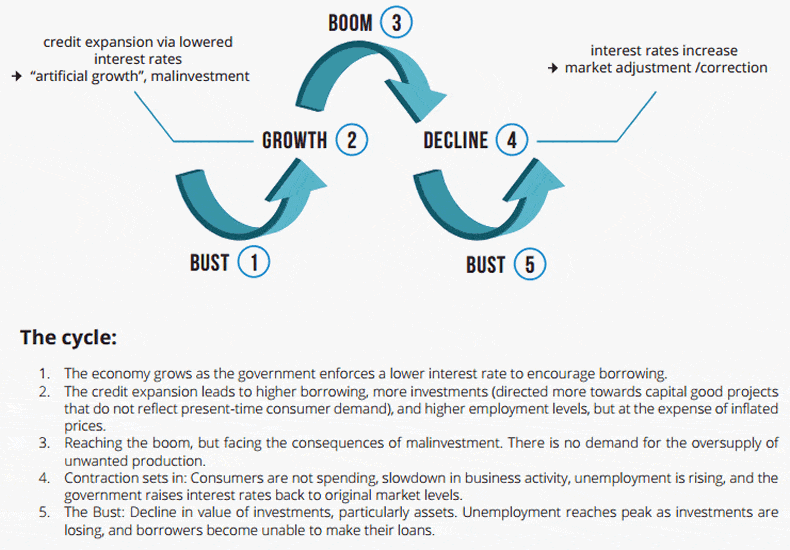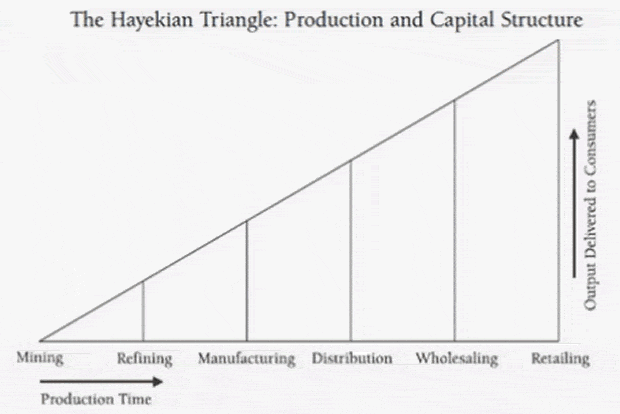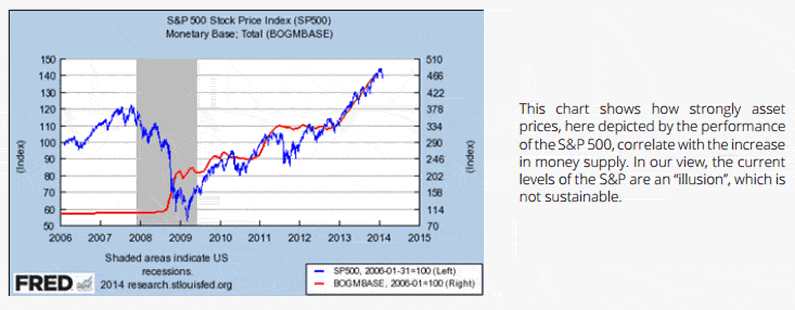“The key of the ABCT is that economies operate in cycles, they go through ‘booms’ and ‘busts’, ‘expansions’ and ‘recessions.’ A ‘crisis’ should not come as a surprise. Austrian School economists argue that central banks don’t help in smoothing the amplitude of the cycles, but are actually the root cause of the business cycle. While some may view that the expansionary monetary policy can mitigate the adverse effects of a crisis, the Austrian School begs to differ.
The paper does an outstanding job in explaining the ABCT and applying it on the major business cycles of the modern US economy. It also answers the question whether we have seen the end of the current crisis (“bust”). Although Barack Obama believes that “we have cleared away the rubble from the financial crisis and begun to lay a new foundation for stronger, more durable economic growth”, this report will tell you otherwise.
The Austrian Business Cycle Theory
Mises and Hayek believed that business cycles are a direct cause of excessive credit flow into the market, which is facilitated by an intentionally low interest rate set by the government. The supply of credit gives the false impression that money originally saved for investment has increased. By doing so, banks mislead borrowers into believing that the pool of investible funds is bigger, and therefore they tend to do what entrepreneurs do: invest in larger production facilities or projects they originally could not afford to finance. These investments bear what economists describe as a “longer process of production”, or capital good industries that stimulate a shift of investment away from consumer goods. This shift is unsustainable, and eventually a correction ensues. The reason is that you have a market that is out of balance and falsely directed to a level of investments that is far from reality. In other words, the state has instigated unsustainable growth.

What happens when the central bank comes in and artificially lowers the interest rate? To explain we take a look at the chart below prepared by Roger Garrison. In this chart, which relies on the Hayekian triangle depicting the different stages of production, Garrison illustrates how a change in the economy’s money supply affects its structure of production. The curve of the Production Possibility Frontier (PPF) shows different combinations of consumption and investment for any given economy (chart on the top right). Any point on the PPF curve is a sustainable mix between consumption and investment (savings).
There are three main scenarios:
- In a pro-savings economy: Investments go up, encouraged by a drop in interest rates. This point on the PPF corresponding to this lower interest rate shows that the economy directs its investments to earlier stages of production. As a result, the triangle expands horizontally.
- In a pro-consumption economy: Savings and investments (discouraged by the rise in interest rates) decrease. As a result, the triangle becomes shorter from the horizontal axis as investments go to lower order consumer goods.
- In the case of a policy-induced credit expansion: This scenario is depicted in the graph as Saug. Here we have two opposing factors at play as a result of the drop in interest rate. As it appears in the graph, the new interest rate encourages both an increase in investment as well as discouraging savings. The low interest rate intersects with both S (the real supply of money by savers given that low interest rate) and Saug (the supply induced by the central bank). These are basically the “mixed signals” we were talking about earlier. Both points are located on the PPF, but meet outside the curve, implying this level is neither efficient nor sustainable.

Who is behind the boom and hence responsible for the bust?
According to the ABCT and the Austrians, it all starts with the primary engineer of the cycle: the government. Any form of state intervention is an attempt to influence markets to prolong the process of needed adjustment and reallocation of resources to more productive uses. Therefore, by manipulating interest rates, governments negatively impact the economy as creators of the growth bubble– which in essence is artificial, distorted and imbalanced.
The illusion behind the boom
The illusion lies in the misallocation of investments or ‘malinvestment’, using Mises’ terminology. This mismanagement involves two concepts: “time preference” and “forced savings”. We recommend readers to go through the explanation of these concepts in the paper (embedded at the bottom). But for now, we highlight the following: It is a play on consumer behavior: Present consumption carries more value to individuals than future consumption. When interest rates are intentionally lowered, consumers are misled to thinking more money is available, and ready to be spent – when in fact their purchasing power, as per forced saving, has weakened. In this inflationary environment, everything is an illusion. Everything has become more expensive, whether wages, commodities, services, even assets and real estate.

From boom to bust….”
If you enjoy the content at iBankCoin, please follow us on Twitter

